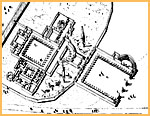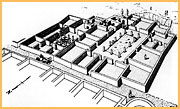|
Athens: From Paganism to Christianity
Throughout the Early Byzantine period, Athens remained
a st ronghold
of polytheist religion and learning. Its rhetorical and philosophical
schools attracted numerous scholars.
Julian (361-363),
the last emperor to support polytheism, met several sophists
and rhetors during his sojourn in Athens (355), and restored
many of the pagan temples ruined in 267, when the Herulians
sacked the city. Athens displays few and rather late signs
of the rise of Christianity. The Library of Hadrian
tetraconch,
the first major church built in the city's monumental centre,
dates of the fifth century. It was probaly dedicated to the
Virgin Mary (as suggested by the name of the subsequent twelfth-century
chapel, Megale Panagia or Great St Mary's), the natural rival
of the city's traditional patroness, the goddess Athena, whose
statue stood on the Acropolis until well into the fifth century,
protecting according to common belief the city from alien
invadors. Justinian's ban of 529 on teaching by polytheists,
which led to the closure of the Athenian schools, was the
final blow to the city's prestige. Under the same emperor
(or by 693 at the very latest), the Parthenon, Athena's temple,
was converted into a cathedral, and dedicated to the Virgin
Mary. ronghold
of polytheist religion and learning. Its rhetorical and philosophical
schools attracted numerous scholars.
Julian (361-363),
the last emperor to support polytheism, met several sophists
and rhetors during his sojourn in Athens (355), and restored
many of the pagan temples ruined in 267, when the Herulians
sacked the city. Athens displays few and rather late signs
of the rise of Christianity. The Library of Hadrian
tetraconch,
the first major church built in the city's monumental centre,
dates of the fifth century. It was probaly dedicated to the
Virgin Mary (as suggested by the name of the subsequent twelfth-century
chapel, Megale Panagia or Great St Mary's), the natural rival
of the city's traditional patroness, the goddess Athena, whose
statue stood on the Acropolis until well into the fifth century,
protecting according to common belief the city from alien
invadors. Justinian's ban of 529 on teaching by polytheists,
which led to the closure of the Athenian schools, was the
final blow to the city's prestige. Under the same emperor
(or by 693 at the very latest), the Parthenon, Athena's temple,
was converted into a cathedral, and dedicated to the Virgin
Mary.
The city's glorious past nurtured the loyalty of its
elite. Both the polytheist civic aristocracy and the growing
Christian community invested their wealth into the revival
of the city after the damaging Herulian (267), Gothic (396)
and Slav (c. 582) invasions. Empress
Eudocia was
herself an Athenian. Born Athenais, she was the daughter of
the polytheist sophist Leontius. Eudocia embraced Christianity
upon marrying
Theodosios II
in 421, a nd
distinguished herself as a patroness of the Church and monasticism
both in Constantinople and in Palestine, where she sought
refuge in the early 440s. In her native city, Eudocia erected
a large palace for herself and her brother Gessius, who was
made praetorian prefect of Illyricum (which included Greece)
soon after his sister's marriage. She may also have commissioned
the tetraconch church in the Library of Hadrian. The so-called
Palace of Eudocia or Gessius', a grandiose complex combining
private and public functions, was built in the Agora in the
420s. Its monumental porch was supported by four pedestals
made of reused materials and adorned with six mid-second-century
colossal statues of Giants and Tritons (three of which remain
in place). The porch led onto a formal collonaded
atrium. which
a double vestibule and a semi-circular courtyard connected
with the residence proper. Two peristyle courtyards articulated
the residential and recreational wings, with their numerous
rooms, bathing facilities (the latter added in the first half
of the sixth century), and service areas; a spacious
Triclinium lay
at the far end of the larger court. The palace was surrounded
by gardens. nd
distinguished herself as a patroness of the Church and monasticism
both in Constantinople and in Palestine, where she sought
refuge in the early 440s. In her native city, Eudocia erected
a large palace for herself and her brother Gessius, who was
made praetorian prefect of Illyricum (which included Greece)
soon after his sister's marriage. She may also have commissioned
the tetraconch church in the Library of Hadrian. The so-called
Palace of Eudocia or Gessius', a grandiose complex combining
private and public functions, was built in the Agora in the
420s. Its monumental porch was supported by four pedestals
made of reused materials and adorned with six mid-second-century
colossal statues of Giants and Tritons (three of which remain
in place). The porch led onto a formal collonaded
atrium. which
a double vestibule and a semi-circular courtyard connected
with the residence proper. Two peristyle courtyards articulated
the residential and recreational wings, with their numerous
rooms, bathing facilities (the latter added in the first half
of the sixth century), and service areas; a spacious
Triclinium lay
at the far end of the larger court. The palace was surrounded
by gardens.
In its complex plan and generous proportions, Eudocia's
palace resembles the vast rural villas of the Roman west,
such as those of Piazza Armerina in Sicily, or Montmaurin
in southern Gaul. It was, however, clearly set in urban surroundings.
Just south of the palace, on the north slope of the Areopagus,
several mansions and public bathing establishments have been
excavated. The former were built or remodelled in the fifth
and sixth centuries by polytheist aristocrats, and have arrangements
similar to those of the urban mansions of Apamea, such as
peristyle courtyards and opulent reception rooms. House C
(also known as Omega House) features an interesting apsed
Triclinium. The rectangular end of the room is paved with a
broad pi-shaped mosaic, upon which the dining couches were
placed. Its apsed domed end was occupied by a semi-circular
stepped basin supplied in water by a natural spring. The Triclinium
provided a cool getaway during the hot summer months. House
C was adorned with a number of antique marble statues, all
of which were removed and hidden in the early sixth century.
|